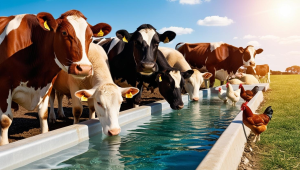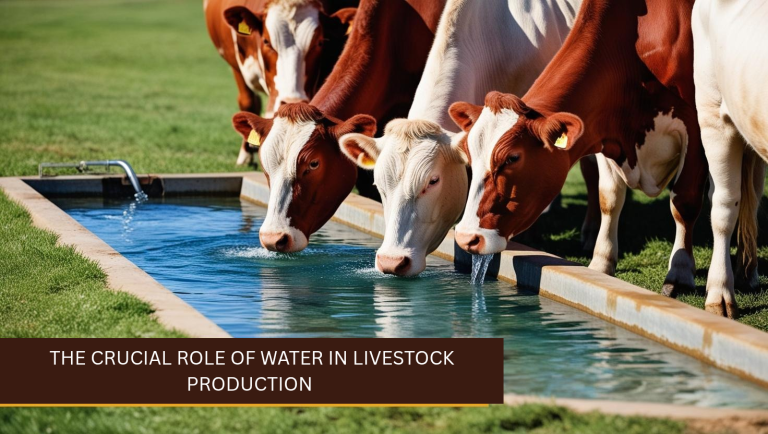Water is an essential component of livestock production, playing a crucial role in maintaining animal health, ensuring optimal growth, and sustaining agricultural operations. As one of the most critical resources in livestock farming, water directly impacts productivity, feed efficiency, and overall farm sustainability. This article explores the multifaceted role of water in livestock production, covering its importance in animal physiology, feed digestion, hygiene, and environmental sustainability.
Click HERE to join our WhatsApp group
Importance of Water for Livestock Health and Physiology
Water is a fundamental requirement for all physiological functions in livestock, including digestion, temperature regulation, circulation, and waste excretion. Animals require a continuous supply of clean and fresh water to survive and thrive. Some key physiological roles of water include:
a. Regulation of Body Temperature
Livestock rely on water to regulate their body temperature through processes like sweating and respiration. This is particularly important in warm climates where heat stress can lead to reduced productivity and health issues.
READ ALSO: Prevention of Disease and Health Management in Poultry farming
b. Nutrient Transport and Digestion
Water acts as a solvent, facilitating the digestion and absorption of nutrients from feed. It helps transport essential nutrients to various body parts and aids in the removal of waste materials.
c. Reproductive Health

Proper hydration is crucial for reproductive efficiency in livestock. Water deficiency can lead to reduced fertility rates, poor conception rates, and increased calving or lambing complications.
READ ALSO: Leptospirosis in Pigs
Water Requirements for Different Livestock Species
Different livestock species have varying water requirements, depending on factors such as body weight, diet, climate, and activity levels. Below are approximate daily water requirements for common livestock:
Cattle: 30-50 liters per day
Sheep and Goats: 4-10 liters per day
Pigs: 10-20 liters per day
Poultry: 0.5-1 liter per day (per 10 birds)
These values can increase significantly in hot weather or for high-producing animals, such as lactating cows, which may require over 100 liters per day.
READ ALSO: Impact Of Ammonia And Humidity On Poultry
Water and Feed Efficiency
Water intake is closely linked to feed consumption and overall efficiency in livestock production. Insufficient water availability leads to reduced feed intake, poor digestion, and lower weight gain in animals.
Ruminants (Cattle, Sheep, Goats): Require ample water for microbial fermentation in the rumen, which is essential for breaking down fibrous plant materials.
Poultry and Pigs: Need constant access to water to facilitate efficient digestion and nutrient absorption.
Dairy Cattle: High milk production demands significant water intake, as milk consists of about 87% water.
Click HERE to join our WhatsApp group
Water Quality and Livestock Health
Providing clean and uncontaminated water is essential for maintaining animal health. Poor-quality water can lead to disease outbreaks and reduced productivity.
a. Contaminants in Water Sources
Common contaminants affecting water quality include:
Bacteria and Pathogens: Can cause diseases like diarrhea and mastitis.
Chemical Pollutants: High levels of nitrates, heavy metals, or pesticides can be toxic to animals.
Algal Blooms: Occur in stagnant water sources and can produce harmful toxins.
READ ALSO: FREQUENTLY ASKED QUESTIONS BY POULTRY FARMERS
b. Water Treatment and Management
Farmers must regularly test and treat water sources to ensure quality. Methods such as filtration, chlorination, and aeration help maintain clean water supplies for livestock.
Role of Water in Livestock Hygiene and Biosecurity
Water plays a vital role in maintaining hygiene on farms. Proper sanitation prevents the spread of diseases and improves animal welfare.
Drinking Equipment: Regular cleaning of troughs and water dispensers prevents contamination.
Facility Cleaning: Water is used to clean barns, milking parlors, and feeding areas to minimize disease risks.
Disease Control: Proper water management helps prevent waterborne diseases such as leptospirosis and salmonellosis.
Water Use Efficiency and Sustainability in Livestock Production
With increasing concerns about water scarcity and climate change, sustainable water management is vital for livestock production. Some strategies to enhance water use efficiency include:
a. Water Conservation Practices
Efficient Irrigation for Feed Crops: Using drip irrigation or rainwater harvesting reduces water wastage in feed production.
Recycling and Reusing Water: Wastewater from farms can be treated and reused for non-drinking purposes.
Reducing Water Waste in Livestock Operations: Installing automatic water dispensers minimizes spillage and overuse.
READ ALSO: Marek’s Disease in Chickens
b. Alternative Water Sources
Rainwater Harvesting: Collecting and storing rainwater for livestock use.
Desalination and Water Treatment: Using treated wastewater or desalinated water in water-scarce areas.
Challenges and Future Perspectives
Despite the crucial role of water in livestock production, challenges such as climate change, droughts, and competition for water resources pose risks to the industry. To address these issues, farmers and policymakers must:
Develop water-efficient livestock farming systems.
Invest in research and technology to improve water management.
Encourage sustainable practices to balance livestock production with environmental conservation.
Conclusion
Water is indispensable in livestock production, affecting animal health, feed efficiency, hygiene, and sustainability. Ensuring adequate water supply and quality is fundamental to maximizing livestock productivity while promoting environmental stewardship. Farmers and stakeholders must prioritize water management strategies to secure the future of livestock farming in an increasingly water-constrained world.
READ ALSO: TRANSIT RELATED MORTALITY IN CHICKS
Many of the challenges bedevilling the Nigeria poultry industry e.g. poor quality of chicks by some hatcheries, substandard drugs, break in vaccine cold chain, high level of toxins in feed materials and finished feeds, poor regulation etc., logistics is another major challenge faced by the industry…
READ ALSO: Behaviour differences linked to broiler growth rates
In a study on the effects of genetic strain, stocking density, and age on broiler behavior, a larger percentage of slow-growing broilers were observed standing, walking and preening while more conventional broilers sat in a lateral posture…
Click HERE to join our WhatsApp group

